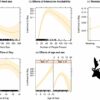An analysis of beeswax in managed honeybee hives in New York found a wide variety of pesticide, herbicide and fungicide residues—exposing current and future generations of bees to long-term toxicity.
The study, published in the Journal of Veterinary Diagnostic Investigation, notes that people may be similarly exposed through contaminated honey, pollen and wax in cosmetics. Though the chemicals found in wax are not beneficial to humans, the small amounts in these products are unlikely to pose a major risk to human health, as compared to their impact on bees.
Bees reuse wax over years, causing chemicals to accumulate, including those that are no longer in use in New York but remain in beeswax.
“Because pesticides can accumulate in wax, it’s important for beekeepers to keep removing old wax every few years and having the bees replace it to make sure the colonies and the bee products remain healthy,” said Dr. Karyn Bischoff, a veterinarian and associate professor of practice in the Department of Population Medicine and Diagnostic Sciences at the College of Veterinary Medicine and the study’s lead author.
Toxic residues get into beeswax from nectar and pollen of plants that have been sprayed with pesticides, and from drugs and pesticides that beekeepers apply to hives to improve bee health. Bees use wax to make combs containing cells that store their brood, honey and pollen. Toxicants, including insecticides, herbicides and fungicides from surrounding agricultural areas, can affect the health of individual workers and brood (eggs, larvae and pupae).
Healthy bees are vital to New York’s economy and agriculture. The state’s beekeeping industry generated close to $11 million worth of honey in 2020 and annually generates $300 million in pollination services to agriculture, according to the paper.
The researchers analyzed wax donated by hobby and commercial beekeepers, as well as by sideliner beekeepers, who sell bee products. Samples from 72 managed honeybee colonies were analyzed by co-authors Scott McArt, Ph.D., associate professor of entomology in the College of Agriculture and Life Sciences, and Nicholas Baert, a former research associate in McArt’s lab.
Pesticides were found in all samples and researchers tallied up to 34 fungicides, 33 insecticides and 22 herbicides, with each wax sample averaging about 18 residues. Wax sent by commercial beekeepers contained the most residues (averaging 22 per sample), followed by hobbyists (16 residues), and sideliners (12 residues).
“Commercial beekeepers had the most pesticides, which makes sense because those bees are exposed to a lot of different crops, and farmers may use different pesticides for each,” Bischoff said.
The most common chemicals found, in 86% of samples, were acaricides, a class of insecticides which beekeepers use to protect honeybees from varroa mites. These mites are very large compared to bees (comparable to a grapefruit-sized tick on a human) and are associated with very high bee losses over winter.
“While varroacides are harmful to bees, they cause less harm than the parasites they are controlling,” Bischoff said.
Almost every sample (98.6%) contained piperonyl butoxide, a compound that makes animals, insects and fungi more sensitive to insecticides and fungicides, making them more effective.
Systemic insecticides (placed on seeds before planting and spreading to all parts of a plant as it grows), called neonics, were also common in samples.
A companion paper, “The Role of the Veterinary Diagnostic Toxicologist in Apiary Health,” led by Bischoff, was also published in the Journal of Veterinary Diagnostic Investigation.
Understanding which contaminants are impacting domestic honeybees may help researchers better protect other pollinators, including wild bees and other insects, as well as birds and bats, Bischoff said.
“Protecting these other species will also help preserve variety in the human diet, since so many of the foods we eat rely on both domestic and wild pollinators,” she said.
Jennifer Moiseff, manager at the toxicology lab (where Bischoff is director) at the Animal Health Diagnostic Center (CVM), is a co-author of the second paper.
More information:
Karyn Bischoff et al, Pesticide contamination of beeswax from managed honey bee colonies in New York State, Journal of Veterinary Diagnostic Investigation (2023). DOI: 10.1177/10406387231199098
Karyn Bischoff et al, The role of the veterinary diagnostic toxicologist in apiary health, Journal of Veterinary Diagnostic Investigation (2023). DOI: 10.1177/10406387231203965
Provided by
Cornell University
Citation:
Pesticides, herbicides, fungicides detected in New York state beeswax (2023, November 9)



